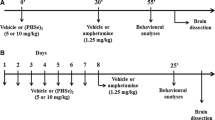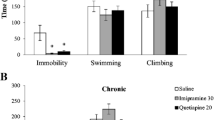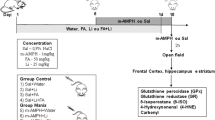Abstract
Studies have demonstrated that oxidative stress is associated with amphetamine-induced neurotoxicity, but little is known about the adaptations of antioxidant enzymes in the brain after amphetamine exposure. We studied the effects of acute and chronic amphetamine administration on superoxide dismutase (SOD) and catalase (CAT) activity, in a rodent model of mania. Male Wistar rats received either a single IP injection of d-amphetamine (1 mg/kg, 2 mg/kg, or 4 mg/kg) or vehicle (acute treatment). In the chronic treatment rats received a daily IP injection of either d-amphetamine (1 mg/kg, 2 mg/kg, or 4 mg/kg) or vehicle for 7 days. Locomotor behavior was assessed using the open field test. SOD and CAT activities were measured in the prefrontal cortex, hippocampus, and striatum. Acute and to a greater extent chronic amphetamine treatment increased locomotor behavior and affected SOD and CAT activities in the prefrontal cortex, hippocampus and striatum. Our findings suggest that amphetamine exposure is associated with an imbalance between SOD and CAT activity in the prefrontal cortex, hippocampus and striatum.






Similar content being viewed by others
References
Kuloglu M, Ustundag B, Atmaca M et al (2002) Lipid peroxidation and antioxidant enzyme levels in patients with schizophrenia and bipolar disorder. Cell Biochem Funct 20:171–175
Ozcan ME, Gulec M, Ozerol E et al (2004) Antioxidant enzyme activities and oxidative stress in affective disorders. Int Clin Psychopharmacol 19:89–95
Ranjekar PK, Hinge A, Hegde MV et al (2003) Decreased antioxidant enzymes and membrane essential polyunsaturated fatty acids in schizophrenic and bipolar mood disorder patients. Psychiatry Res 121:109–122
McQuillin A, Bass NJ, Kalsi G et al (2006) Fine mapping of a susceptibility locus for bipolar and genetically related unipolar affective disorders, to a region containing the C21ORF29 and TRPM2 genes on chromosome 21q22.3. Mol Psychiatry 11:134–142
Shao L, Young LT, Wang JF (2005) Chronic treatment with mood stabilizers lithium and valproate prevents excitotoxicity by inhibiting oxidative stress in rat cerebral cortical cells. Biol Psychiatry 58:879–884
Murphy DL, Brodie HK, Goodwin FK et al (1971) Regular induction of hypomania by L-dopa in “bipolar” manic-depressive patients. Nature 229:135–136
Gerner RH, Post RM, Bunney WE Jr (1976) A dopaminergic mechanism in mania. Am J Psychiatry 133:1177–1180
Jacobs D, Silverstone T (1986) Dextroamphetamine-induced arousal in human subjects as a model for mania. Psychol Med 16:323–329
Einat H, Kofman O, Belmaker RH (2000) Animal models of bipolar disorder: From A single episode to progressive cycling models. In: Myslobodsky MS, Weiner I (eds) Contemporary issues in modeling psychopathology. Kluwer Academic, Boston, pp 165–179
Machado-Vieira R, Kapczinski F, Soares JC (2004) Perspectives for the development of animal models of bipolar disorder. Prog. Neuropsychopharmacol. Biol. Psychiatry 28:209–224
Frey BN, Andreazza AC, Ceresér KMM et al (In press) Effects of mood stabilizers on hippocampus BDNF levels in an animal model of mania. Life Sci
Frey BN, Martins MR, Petronilho FC et al (In press) Increased oxidative stress after repeated amphetamine exposure: possible relevance as an animal model of acute mania. Bipolar Disord
Aebi H (1984) Catalase in vitro. Methods Enzymol 105:121–126
Bannister JV, Calabrese L (1987) Assays for superoxide dismutase. Methods Biochem Anal 32:279–312
Floyd RA (1999) Antioxidants, oxidative stress, and degenerative neurological disorders. Proc Soc Exp Biol Med 222:236–245
Klamt F, Dal-Pizzol F, Conte da Frota ML et al (2001) Imbalance of antioxidant defense in mice lacking cellular prion protein. Free Radic Biol Med 30:1137–1144
Andrades M, Ritter C, Moreira JC et al (2005) Oxidative parameters differences during non-lethal and lethal sepsis development. J Surg Res 125:68–72
Cadet JL, Brannock C (1998) Free radicals and the pathobiology of brain dopamine systems. Neurochem Int 32:117–131
Brown JM, Yamamoto BK (2003) Effects of amphetamines on mitochondrial function: Role of free radicals and oxidative stress. Pharmacol Ther 99:45–53
Jayanthi S, Ladenheim B, Cadet JL (1998) Methamphetamine-induced changes in antioxidant enzymes and lipid peroxidation in copper/zinc-superoxide dismutase transgenic mice. Ann N Y Acad Sci 844:92–102
Carvalho F, Fernandes E, Remiao F et al (2001) Adaptative response of antioxidant enzymes in different areas of rat brain after repeated d-amphetamine administration. Addict Biol 6:213–221
D’Almeida V, Camarini R, Azzalis LA et al (1995) Antioxidant defense in rat brain after chronic treatment with anorectic drugs. Toxicol Lett 81:101–105
Iida M, Miyazaki I, Tanaka K et al (1999) Dopamine D2 receptor-mediated antioxidant and neuroprotective effects of ropinirole, a dopamine agonist. Brain Res 838:51–59
Yoshioka M, Tanaka K, Miyazaki I et al (2002) The dopanime agonist cabergoline provides neuroprotection by activation of the glutathione system and scavenging free radicals. Neurosci Res 43:259–67
O’Neill MJ, Hicks CA, Ward MA et al (1998) Dopamine D2 receptor agonists protect against ischaemia-induced hippocampal neurodegeneration in global cerebral ischaemia. Eur J Pharmacol 352:37–46
Ryan LJ, Linder JC, Martone ME et al (1990) Histological and ultrastructural evidence that D-amphetamine causes degeneration in neustriatum and frontal cortex of rats. Brain Res 518:67–77
Eisch AJ, Gaffney M, Weihmuller FB et al (1992) Striatal subregions are differentially vulnerable to the neurotoxic effects of methamphetamine. Brain Res 598:321–326
Hsieh YS, Yang SF, Chiou HL et al (in press) Activations of c-fos/c-jun signaling are involved in the modulation of hypothalamic superoxide dismutase (SOD) and neuropeptide Y (NPY) gene expression in amphetamine-mediated appetite suppression. Toxicol Appl Pharmacol
Antoniou K, Kafetzopoulos E, Papadopoulou-Daifoti Z et al (1998) d-amphetamine, cocaine and caffeine: a comparative study of acute effects on locomotor activity and behavioural patterns in rats. Neurosci Biobehav Rev 23:189–196
Ott DA, Mandel RJ (1995) Amphetamine sensitivity in open-field activity vs. the prepulse inhibition paradigm. Brain Res Bull 37:219–222
Acknowledgements
This study was partly supported by CNPq, FAPESC, UNESC, and CAPES Foundation (Brazil).
Author information
Authors and Affiliations
Corresponding author
Rights and permissions
About this article
Cite this article
Frey, B.N., Valvassori, S.S., Réus, G.Z. et al. Changes in Antioxidant Defense Enzymes after d-amphetamine Exposure: Implications as an Animal Model of Mania. Neurochem Res 31, 699–703 (2006). https://doi.org/10.1007/s11064-006-9070-6
Accepted:
Published:
Issue Date:
DOI: https://doi.org/10.1007/s11064-006-9070-6




